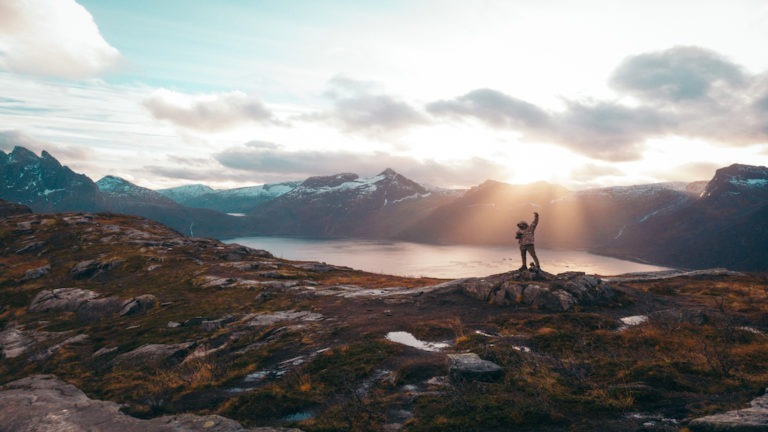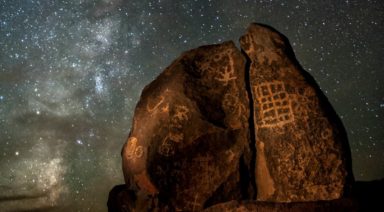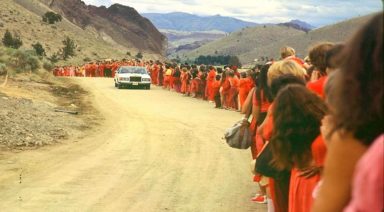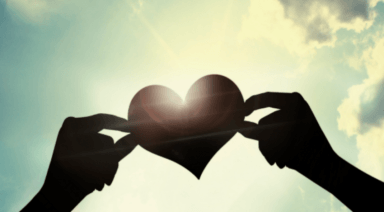What is the Hero’s Journey?

When I was in my early 20s and my father was dying, a friend gave me a painting. It depicted a river wending its way through soft mountains, with a small sailboat in the distance floating down the river. It struck me at the time as a metaphor for my life. And I was left with the sense that our life is like the journey in a fairy tale, a small vessel following the currents, passing through different terrains, in search of what’s around the next corner. The river knows where it’s going, but we on the boat do not.
On this life journey, we are each discovering the geography of our own inner world. And yet, when we take a step back and look at it from a larger perspective, that geography, and our life journey, is not so different from the basic story that humankind has been playing out since the beginning. Birth. Separation. Initiation.
Return. This shows up in our own lifecycle, and then in the countless ways that we are called to leave what is familiar to us and venture into the unfamiliar. Each of us slaying inner dragons and facing outer obstacles, to be reborn in a new version of ourselves, more true to who we are.
This death and rebirth motif shows up in stories and myths all over the world; is at the heart of some of our great religions; and animates our most powerful films.
George Lucas, struggling for years to create a film his heart had been calling him to write, was able to finish the Star Wars story while reading Joseph Campbell’s The Hero with a 1000 Faces, which lays out the basic bones of the human story. Just as the heroes and heroines in that saga overcome fear and attachment to the familiar and rise up to be of real service to the Universe, we are each doing the same thing in our own universe.
Each of us is rising above our self-imposed limitations and outer challenges to expand our sense of self and walk our path of destiny. Joseph Campbell and the Hero’s Journey gave us a map to guide us, and signposts along the way, as we take our journey.
Myth as Metaphor
Before we explore the Hero’s Journey, we might remember that fairy tales and myths are not presented as historical truth, but are important as psychological truth. The demons, dragons, and allies that show up in myths are the projections of our own inner energies. That’s why there is such unity across all cultures and time periods, in what Joseph Campbell called the monomyth. For Jung, it was the collective unconscious.
These same energies and symbols show up in our dreams, helping us to recognize these qualities within ourselves. Myths show us our inner story on an outer level, helping us to navigate our lives through the power of metaphor, and teaching us how to cross the thresholds and face our dragons.
What is the Hero’s Journey?
The Hero’s Journey is a quest for self-transformation, for creative rebirth. We go out and seek, so that we can discover that the seeker is itself the mystery which the seeker seeks to know. You might think of the novel The Alchemist, where the hero returns home to find the treasure buried right where he began.
The basic storyline that Campbell describes in his Hero with a 1000 Faces is this:
“A hero ventures forth from the world of the common day into a region of supernatural wonder; fabulous forces are there encountered and a decisive victory is won; the hero comes back from this mysterious adventure with the power to bestow boons on his fellow man.”
As we trace the steps of this hero’s journey in more detail, think of an iconic story like The Wizard of Oz. Or, more importantly, think of your own life and watch the metaphor unfold in your personal life journey.
1. Separation
We experience a call to action. Something shakes up our ordinary world. Divorce. Illness. Moving to another country. The birth of a child or death of a parent. Some form of crisis or suffering impels us out of our comfort zone. Our journey begins. Some people refuse this call and their life stagnates. But for those of us that answer the call, our life will not be the same.
At this point, the universe offers some help. We meet a mentor who helps to guide us. We read the right book or a dream inspires us. Our higher self is supporting us, and the universe will protect us as we become willing to take the leap into the unknown.
We cross the threshold into unfamiliar territory, and there is no looking back.
Our ego and our fear have loosened its grip upon us enough so that we are already leaving behind who we were and opening up to what awaits.
2. Initiation
More allies join us. Or we acquire skills or develop aspects of ourselves previously ignored. With these allies, skills, and newfound parts of ourselves, we face the monsters.
We are tested. This is a dark night of the soul.
We must acknowledge our worst fears and use all of our skills and wisdom to overcome the challenge. Sometimes we are victorious. Sometimes we are not.
3. Return
If we have survived the initiation, our journey is not yet over. We must take what we’ve learned, and integrate it back into our lives.
We cross back over the threshold, different, with more awareness, with something to offer those around us.
Maybe it’s the story that we bring back that is the biggest gift. Or maybe we now are called to teach others the skills we acquired. We resume our life in an upgraded form.
The Heroine’s Journey
We can also examine this pattern from a feminine perspective. Maureen Murdoch, in her book The Heroine’s Journey, sees the death-rebirth theme in terms of the need to slay the monster of the status quo of a patriarchal world. Each of us who have internalized the devaluation of the feminine, and have rejected parts of ourselves because of that, is on a quest to reconnect with the Goddess and heal our connection to our body, our spirit, and to nature.
Our inner demons – the feeling that we can never be enough, that we constantly have to do and achieve in order to be worthy – are disconnecting us from our authentic selves. And it is by listening to our bodies, and finding community amongst other seekers, that we can be reborn as whole and healed.
Demeter and Persephone
Murdoch explores the universal pattern of separation/initiation/return through the ancient Greek myth of Demeter (or Ceres), an Earth Goddess of grain and the harvest, and her daughter, Persephone. The myth starts with the brutal separation of mother and daughter. Hades, the god of the underworld, abducts the young woman and drags her away from the world of the living. Both mother and daughter then embark upon their own hero’s journeys, which will transform them, as well as the natural world itself.
Demeter, beginning the initiation phase of her journey, searches frantically for her daughter, and is helped by the goddess Hecate who helps her find out not only that Hades had abducted and raped her daughter, but that Zeus, king of the gods and brother to Hades, had sanctioned it.
Enraged by this realization, Demeter wanders around the countryside in grief, and since she is an Earth goddess, the crops begin to fail and there is no food to eat. This becomes a problem for Zeus because the people are no longer making offerings or sacrificing to the gods. Zeus then commands Hades to send Persephone back to her mother so that Demeter will abandon her grief and restore growth and fertility to the earth.
Meanwhile, Persephone has herself crossed the threshold into the underworld, experiencing the dark night of the soul. While there, she becomes queen of the underworld, finding previously unknown parts of herself. The final transformative moment comes when she eats one seed of the pomegranate, the food of the underworld, thereby internalizing the transformation that she has undergone.
Mother and daughter are finally reunited, in the return phase of their journey. But since Persephone had eaten one seed from the pomegranate, she cannot fully go back to what and who she was. In the myth, she is forced to spend one-third of the year in the underworld, during which Demeter mourns her, creating the season of winter when the world lies barren. Both mother and daughter have been transformed by their journeys, more aware of their power and who they truly are.
Be the Hero of Your Own Journey
Carl Jung said, “I made it the task of tasks of my own life to find by what mythology I was living.” So, by what mythology are you living? What has been your greatest call to action? What are your inner demons, or the thresholds you’ve crossed over forever altering your identity? What was your dark night of the soul? Who are your allies, what skills and qualities are you developing now to assist you on your journey?
We might begin to use the heroes and heroines in myths to lead by example. We can invoke these aspects of our own selves to inspire us and give us the courage and strength to walk our path, no matter how winding or dangerous it is. The most rewarding moments in life tend to come after a challenge, so we can even begin to appreciate our inner demons, as well as the dark confused energy that we encounter outside of ourselves.
When we stop fighting against ourselves, we become open to all the avenues of transformation available to us, and we come into alignment with the universe, where we can receive the greatest gifts and support in becoming who we truly are, becoming the hero or heroine of our own journey.
Follow Your Bliss
In his book The Power of Myth, Joseph Campbell writes:
“Now, I came to this idea of bliss because in Sanskrit, which is the great spiritual language of the world, there are three terms that represent the brink, the jumping-off place to the ocean of transcendence: sat-chit-ananda. The word “Sat” means being. “Chit” means consciousness. “Ananda” means bliss or rapture. I thought, “I don’t know whether my consciousness is proper consciousness or not; I don’t know whether what I know of my being is my proper being or not; but I do know where my rapture is. So let me hang on to rapture, and that will bring me both my consciousness and my being.” I think it worked.”
When we feel the flow of the universe when we enjoy what we are doing and love who we are being, we are connecting to our consciousness and our true selves. That is the true result of following our hero’s journey.
In Pathways to Bliss, Campbell writes:
“What is it we are searching for? It is the fulfillment of that which is potential in each of us. Questing for it is not an ego trip; it is an adventure to bring into fulfillment your gift to the world, which is yourself.” When we have truly given the gift of ourselves to the world, we find ways to make a positive difference, and to inspire others to walk their hero’s path. Our life is our story, and when we can speak our story to others, we invite them to make their own journey.
My father’s death was an experience of the dark night of the soul. And yet, it set me on a path towards healing, spirituality, and finding my true self, and for that I am forever grateful. Life has offered many soul journeys since then, and each one has brought me into deeper connection to who I am, and closer to following my bliss.
The Awesome Power of the Field of Love

In February, a lot of us start thinking about Love and it’s not only because our most widely celebrated cross-cultural holiday is observed on February 14th. Apparently people were thinking of Love at that time of year way before there even was a St. Valentine. Maybe it has more to do with winter turning the corner – the first inklings of springtime, softly fizzling in our future.
No, in our reality it isn’t the seasons or saints that inspire a couple billion dollars worth of chocolate to be sold, the harvesting of two hundred million roses, or the wedding engagements of somewhere around five to six million couples, it’s the most powerful extra-dimensional force known to humankind. It’s Love, silly, and it can move mountains.
“None of the means employed…has a sixteenth part of the value of loving-kindness. Loving-kindness, which is freedom of the heart, absorbs them all; it glows, it shines, it blazes forth.”
The Buddha
Love is a powerful field of positive energy that makes all of Life’s greatest spiritual and material manifestations and realizations possible. The more we consciously engage with the field of Love, the greater those manifestations and realizations will be.







